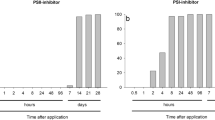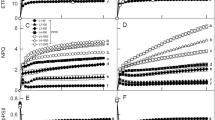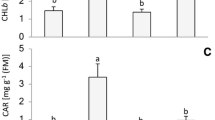Abstract
Simultaneous measurements of chlorophyll (Chl) fluorescence and CO2 assimilation (A) in Vicia faba leaves were taken during the first weeks of growth to evaluate the protective effect of 24-epibrassinolide (EBR) against damage caused by the application of the herbicide terbutryn (Terb) at pre-emergence. V. faba seeds were incubated for 24 h in EBR solutions (2 × 10−6 or 2 × 10−5 mM) and immediately sown. Terb was applied at recommended doses (1.47 or 1.96 kg ha−1) at pre-emergence. The highest dose of Terb strongly decreased CO2 assimilation, the maximum quantum yield of PSII photochemistry in the dark-adapted state (F V/F M), the nonphotochemical quenching (NPQ), and the effective quantum yield (ΔF/F′M) during the first 3–4 weeks after plant emergence. Moreover, Terb increased the basal quantum yield of nonphotochemical processes (F 0/F M), the degree of reaction center closure (1 − q p), and the fraction of light absorbed in PSII antennae that was dissipated via thermal energy dissipation in the antennae (1 − F′V/F′M). The herbicide also significantly reduced plant growth at the end of the experiment as well as plant length, dry weight, and number of leaves. The application of EBR to V. faba seeds before sowing strongly diminished the effect of Terb on fluorescence parameters and CO2 assimilation, which recovered 13 days after plant emergence and showed values similar to those of control plants. The protective effect of EBR on CO2 assimilation was detected at a photosynthetic photon flux density (PFD) of 650 μmol m−2 s−1 and the effect on ΔF/F′M and photosynthetic electron transport (J) was detected under actinic lightings up to 1750 μmol m−2 s−1. The highest dose of EBR also counteracted the decrease in plant growth caused by Terb, and plants registered the same growth values as controls.






Similar content being viewed by others
References
Ali B, Hasan SA, Hayat S, Hayat Q, Yadav S, Fariduddin Q, Ahmad A (2008) A role for brassinosteroids in the amelioration of aluminium stress through antioxidant system in mung bean (Vigna radiate L. Wilczek). Environ Exp Bot 62:153–159
Anuradha S, Rao SSR (2001) Effect of brassinosteroids on salinity stress induced inhibition of seed germination and seedling growth of rice (Oryza sativa L). Plant Growth Regul 33:151–153
Anuradha S, Rao SSR (2003) Application of brassinosteroids to rice seeds (Oryza sativa L.) reduced the impact of salt stress on growth, prevented photosynthetic pigment loss and increased nitrate reductase activity. Plant Growth Regul 40:29–32
Asada K (1999) The water-water cycle in chloroplasts: scavenging of active oxygens and dissipation of excess photons. Annu Rev Plant Physiol Plant Mol Biol 50:601–639
Bishop GJ, Yokota T (2001) Plant steroid hormones, brassinosteroids: current highlights of molecular aspects on their synthesis/metabolism, transport, perception and response. Plant Cell Physiol 42:114–120
Bobrik AO, Khripach VA, Zhabinskii VN, Zavadskaya MI, Litvinovska RP (1998) A method of production of sanitated seed potato. Pat Appl BY 19,981,189
Bolhar-Nordenkampf HR, Long SP, Baker NR, Öquist G, Schreiber U, Lechner EG (1989) Chlorophyll fluorescence as a probe of the photosynthetic competence of leaves in the field: a review of current instrumentation. Funct Ecol 3:497–514
Caballero R, Alzueta C, Barro C, Arauzo M, Hernaiz PJ (1992) Chemical control of annual weeds in field beans (Vicia faba) in Central Spain. Weed Sci 40:96–100
Chen Q, Adams CC, Usack L, Yang J, Monde RA, Stern DB (1995) An AU-rich element in the 3′ untranslated region of the spinach chloroplast petD gene participates in sequence-specific RNA-protein complex formation. Mol Cell Biol 15:2010–2018
Clouse SD, Sasse JM (1998) Brassinosteroids: essential regulators of plant growth and development. Annu Rev Plant Physiol Plant Mol Biol 49:427–451
Cutler HG (1991) Brassinosteroids through the looking glass: An appraisal. In: Cutler HG, Yokota T, Adam G (eds) Brassinosteroids: Chemistry, Bioactivity and Applications, ACS Symp Ser 474. American Chemical Society, Washington, DC, pp 334–345
Deng Z, Zhang X, Tang W, Oses-Prieto JA, Suzuki N, Gendron JM, Chen H, Guan S, Chalkley RJ, Peterman TK, Burlingame AL, Wang ZY (2007) A proteomics study of brassinosteroid response in Arabidopsis. Mol Cell Proteomics 6(12):2058–2071
Eshel Y, Kovacs M, Rubin B (1975) Differential tolerance of peas to prometryne and terbutryn. Pestic Biochem Physiol 5:295–302
Fedke C (1982) Biochemistry and Physiology of Herbicide Action. Springer-Verlag, Berlin, p 202
Genty B, Briantais JM, Baker NR (1989) The relationships between the quantum yield of photosynthetic electron transport and quenching of chlorophyll fluorescence. Biochim Biophys Acta 900:87–92
Hamada K (1986) Brassinolide in crop cultivation. Plant growth regulators in agriculture, FFTC Book Ser 34:188–196
Hasan SA, Hayat S, Ali B, Ahmad A (2008) 28-Homobrassinolide protects chickpea (Cicer arietinum) from cadmium toxicity by stimulating antioxidants. Environ Pollut 151:60–66
Havaux M, Ernez M, Lannoye R (1988) Correlation between heat tolerance and drought tolerance in cereals demonstrated by rapid chlorophyll fluorescence tests. J Plant Physiol 133:555–560
Hoagland DR, Arnold DI (1950) The water culture method for growing plants without soil. Calif Agric Exp Stat Circ No. 347
Kagale S, Divi UK, Krochko JE, Keller WA, Krishna P (2007) Brassinosteroid confers tolerance in Arabidopsis thaliana and Brassica napus to a range of abiotic stresses. Planta 225:353–364
Kiss A, Rapi S, Cs Csuturás (2007) GC/MS studies on revealing products and reaction mechanism of photodegradation of pesticides. Microchemical J 85:13–20
Khripach VA, Zhabinskii VN, Litvinovskaya MI, Savel’eva EA, Karas II, Vakulenko VV (1996) A method of increasing potato food value. Pat Appl BY 960,345
Khripach V, Zhabinskii V, Groot AD (2000) Twenty years of brassinosteroids: steroidal plant hormones warrant better crops for the XXI century. Ann Bot 86:441–447
Krause GH, Weis E (1991) Chlorophyll fluorescence and photosynthesis: the basics. Annu Rev Plant Physiol Plant Mol Biol 42:313–349
Krishna P (2003) Brassinosteroid-mediated stress responses. J Plant Growth Regul 22:289–297
Lazár D (1999) Chlorophyll a fluorescence induction. Biochim Biophys Acta 1412:1–28
Lisso J, Steinhauser D, Altmann T, Kopka J, Müsig C (2005) Identification of brassinosteroid-related genes by means of transcript co-response analyses. Nucleic Acids Res 33:2685–2696
Mandava NB (1988) Plant growth-promoting brassinosteroids. Annu Rev Plant Physiol Plant Mol Biol 39:23–52
Maxwell K, Johnson GN (2000) Chlorophyll fluorescence–a practical guide. J Exp Bot 51:659–668
Nuñez M, Mazzafera P, Mazorra LM, Siqueria WA, Zullo MAT (2003) Influence of brassinosteroid analogue on antioxidant enxymes in rice Brown in culture medium with NaCl. Biol Plant 47:67–70
Ogweno JO, Song XS, Shi K, Hu WH, Mao WH, Zhou YH, Yu JQ, Nogués S (2008) Brassinosteroids alleviate heat-induced inhibition of photosynthesis by increasing carboxylation efficiency and enhancing antioxidant systems in Lycopersicum esculentum. J Plant Growth Regul 27:49–57
Oxborough K, Baker NR (1997) Resolving chlorophyll a fluorescence images of photosynthetic efficiency into photochemical and non-photochemical components–calculations of qP and Fv′/Fm′ without measuring Fo′. Photosynth Res 54:135–142
Pshenichnaya LA, Khripach VA, Volynetz AP, Prokhorchik RA, Manzhelesova NE, Morozik GV (1997) Brassinosteroids and resistance of barley plants to leaves diseases. In: Problems of experimental botany. Byelorussian Science, Minsk, pp 210–217
Rohácek K (2002) Chlorophyll fluorescence parameters: the definitions, photosynthetic meaning and mutual relationships. Photosynthetica 40:13–29
Schreiber U, Bilger W (1993) Progress in chlorophyll fluorescence research: major developments during the past years in retrospect. Progr Bot 54:151–173
Singh I, Shono M (2005) Physiological and molecular effects of 24-epibrassinolide, a brassinosteroid on thermotolerance of tomato. Plant Growth Reg 47:111–119
Sivak MN, Walker DA (1985) Chlorophyll A fluorescence can it shed light on fundamental questions in photosynthetic carbon dioxide fixation. Plant Cell Environ 8:439–448
Vert G, Nemhauser JL, Geldner N, Hong F, Chory J (2005) Molecular mechanisms of steroid hormone signalling in plants. Annu Rev Cell Dev Biol 21:177–201
Vidal D, Martínez J, Bergareche C, Miranda A, Simón E (1992) Effect of methabenzthiazuron on growth and nitrogenase activity in Vicia faba. Plant Soil 144:235–245
Vidal D, Martínez-Guijarro J, Simón E (1995) Chlorophyll fluorescence and photosynthetic O2 evolution in Vicia faba treated with methabenzthiazuron. Photosynthetica 31:9–20
Wang ZY, Wang Q, Chong K, Wang F, Wang L, Bai M, Jia C (2006) The brassinosteoird signal transduction pathway. Cell Res 16:427–434
Wilen RW, Sacco M, Gusta LV, Krishna P (1995) Effects of 24-epibrassinolide on freezing and thermotolerance of bromegrass (Bromus inermis) cell cultures. Physiol Plant 95:195–202
Xiong J, Hutchison RS, Sayre RT, Govindjee (1997) Modification of the photosystem II acceptor side function in a D1mutant (arginine–269-glycine) of Chlamydomonas reinhardtii. Biochim Biophys Acta 1322:60–76
Ye L, Sugiura M (1992) Domains required for nucleic acid binding activities in chloroplast ribonucleoproteins. Nucleic Acids Res 20:6275–6279
Yu JQ, Huang LF, Hu WH, Zhou YH, Mao WH, Ye SF, Nogues S (2004) A role for brassinosteroids in the regulation of photosynthesis in Cucumis sativus. J Exp Bot 55:1135–1143
Zang L, Paakkarinen V, Wijk KJ, van Aro EM (2000) Biogenesis of the chloroplast-encoded D1 protein: regulation of translation elongation, insertion and assembly into photosystem II. Plant Cell 12:1769–1781
Zimmermann K, Heck M, Frank J, Kern J, Vass I, Zouni A (2006) Herbicide binding and thermal stability of photosystem II isolated from Thermosynechococcus elongates. Biochim Biophys Acta 1757:106–114
Acknowledgments
We gratefully acknowledge support from grant CGL2005–05620 from the Ministerio de Educación y Ciencia. We also thank Dr. Carmen Brosa from the I.Q.S., University Ramon Llull, Barcelona, for the gift of 24-epibrassinolide, the Campos Experimentales de la Universitat de Barcelona for technical support, and Robin Rycroft for correcting the English text.
Author information
Authors and Affiliations
Corresponding author
Rights and permissions
About this article
Cite this article
Piñol, R., Simón, E. Effect of 24-Epibrassinolide on Chlorophyll Fluorescence and Photosynthetic CO2 Assimilation in Vicia faba Plants Treated with the Photosynthesis-Inhibiting Herbicide Terbutryn. J Plant Growth Regul 28, 97–105 (2009). https://doi.org/10.1007/s00344-008-9077-0
Received:
Accepted:
Published:
Issue Date:
DOI: https://doi.org/10.1007/s00344-008-9077-0




